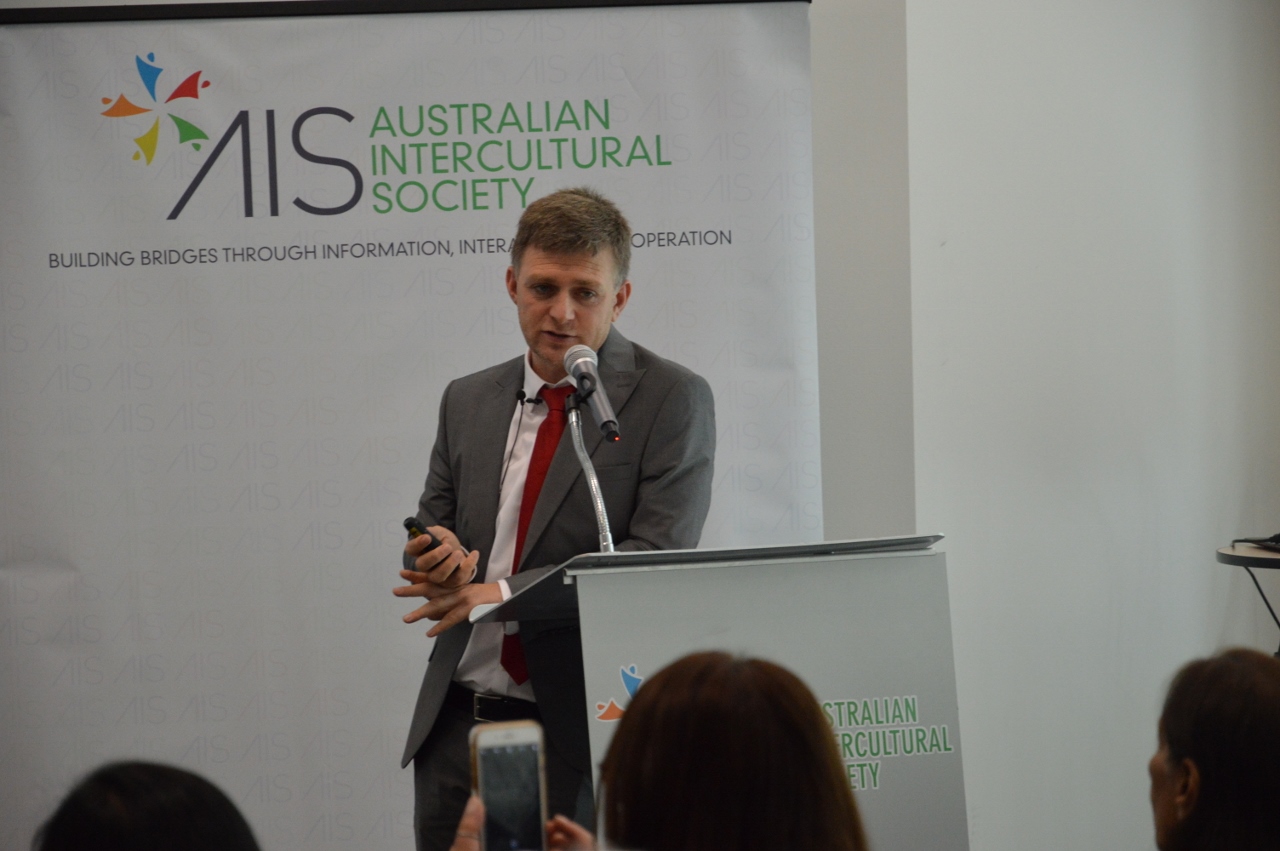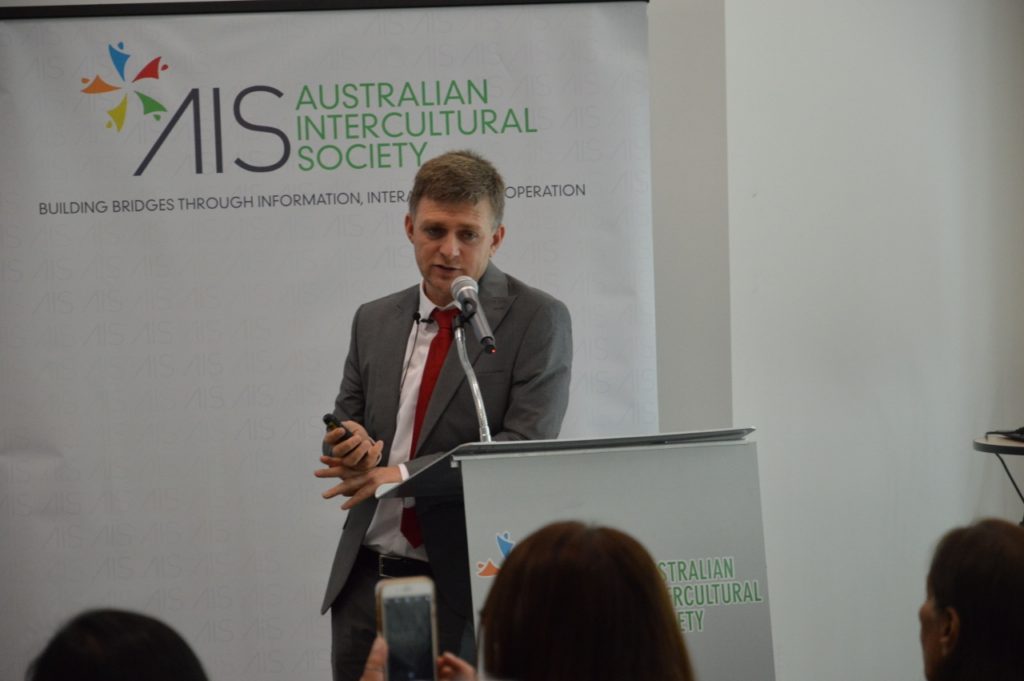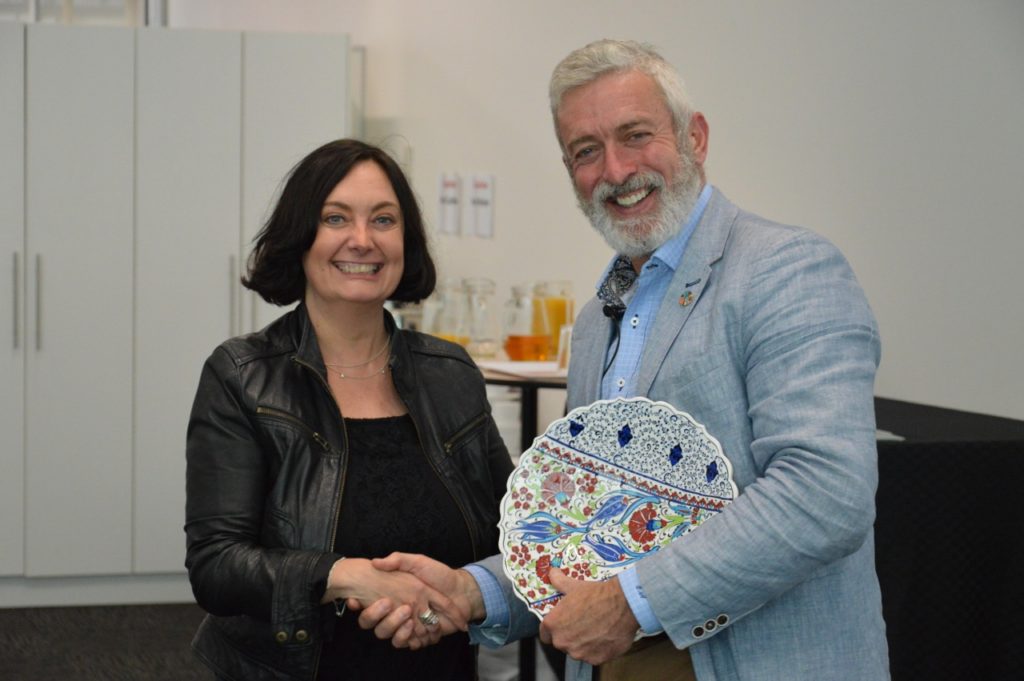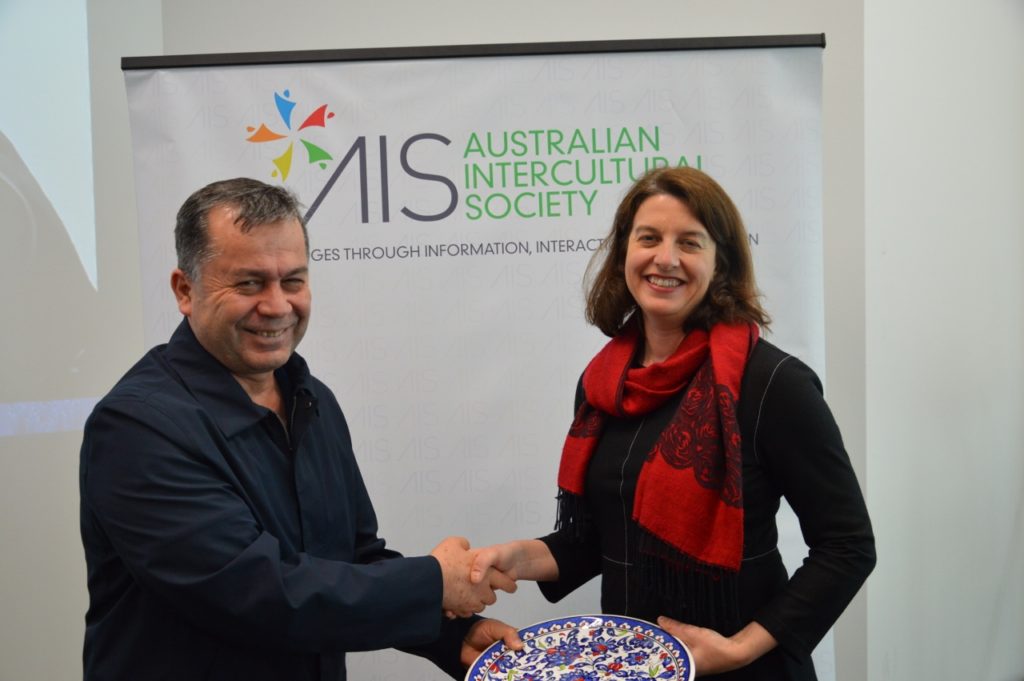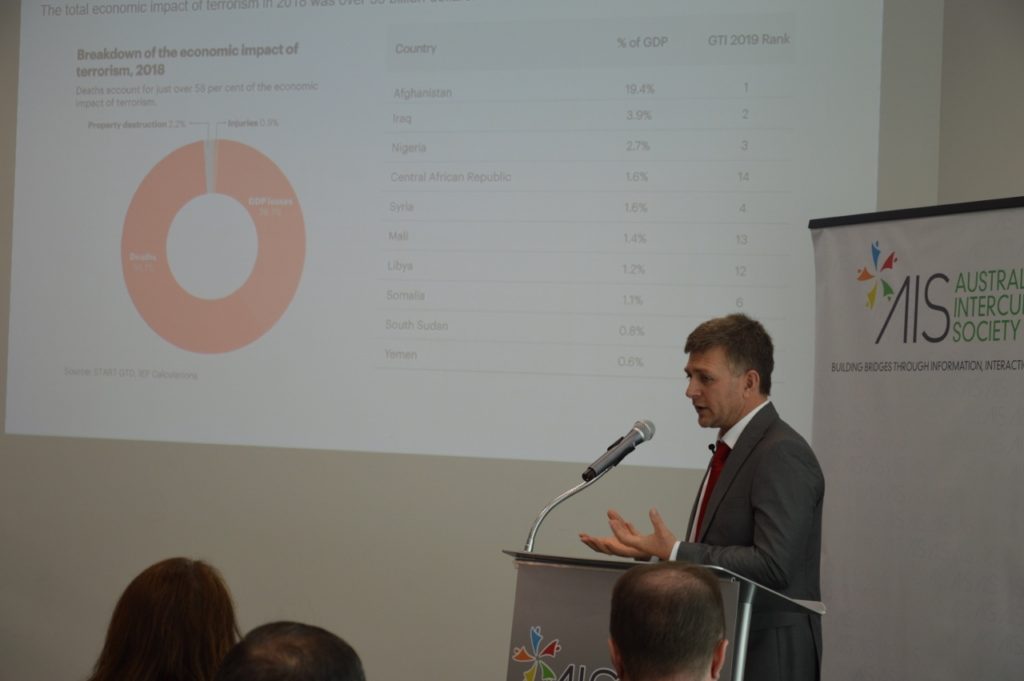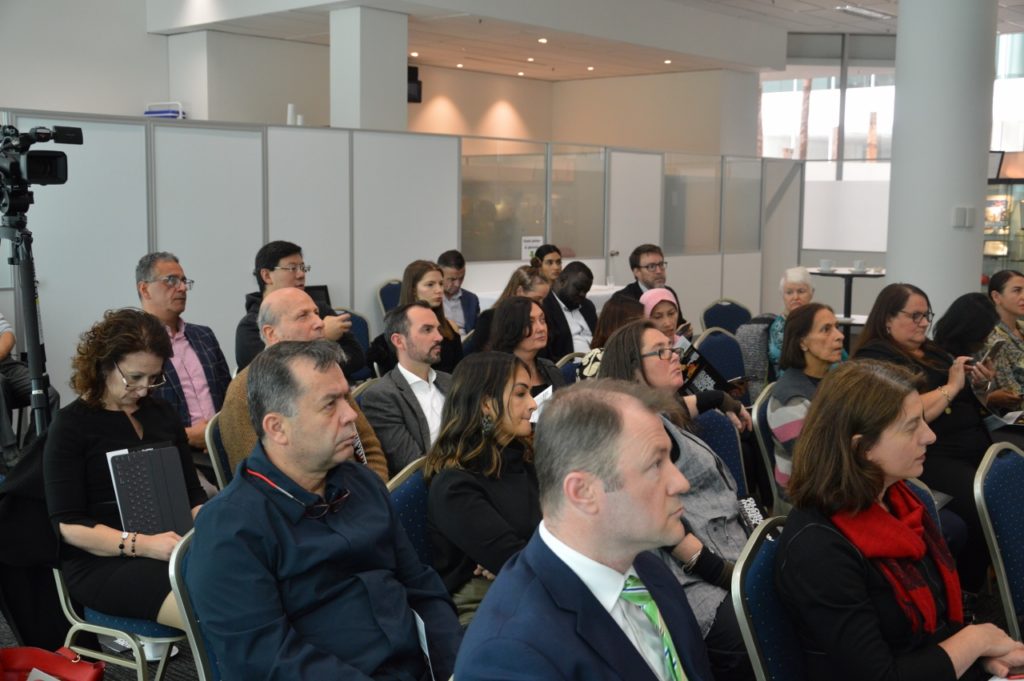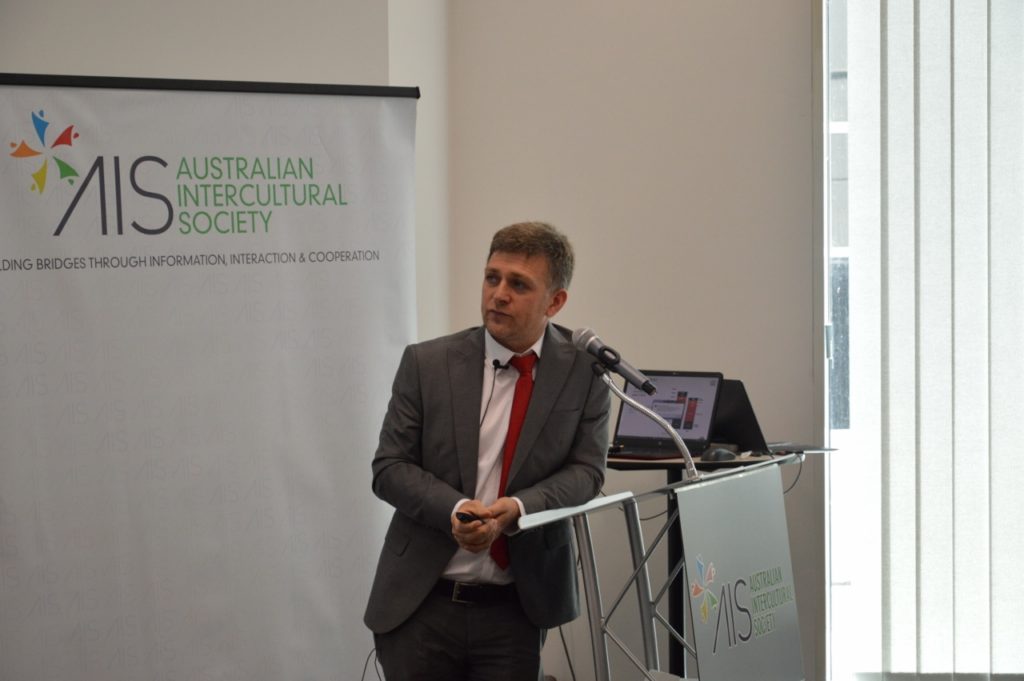‘Measuring Peace and the Economic Cost of Violence: Global Terrorism Index 2019”
On the 26th of November, the Australian Intercultural Society hosted Mohib Iqbal and Charlie Allen from the Institute for Economics and Peace to launch the Global Terrorism Index for 2019. The Institute for Economics and Peace is one of the world’s leading think tank for measuring and costing peace. It’s global indices include the Global Peace Index, the Positive Peace Report and the Terrorism Index. The ground breaking research from the Institute for Economics and Peace provides a pathway to improving global peacefulness.
Some of the findings that the IEP came up with for the 2019 Global Terrorism Index are as follows:
- Results: The total number of deaths from terrorism declined for the fourth consecutive year in 2018, falling by 15.2 per cent to 15,952 deaths. Nine of the ten countries most impacted by terrorism improved. Despite the fall in total deaths, the number of countries affected by terrorism remains high. 71 countries recorded at least one death from terrorism in 2018, the second highest number of countries since 2002. Afghanistan had the largest deterioration, recording 7,379 deaths from terrorism, an increase of 59 per cent from the prior year, and is now at the bottom of the index. For the first time since 2003, Iraq was not the country most impacted by terrorism. The impact of terrorism improved in 98 countries, compared to 40 that deteriorated in the past year. However, the overall impact of terrorism was still higher in 80 countries when compared to five years ago. Iraq and Somalia experienced the largest falls in deaths from terrorism, owing mainly to less activity from ISIL and Al-Shabaab respectively. ISIL’s decline continued for the second successive year. Deaths attributed to the group declined by 69 per cent, and attacks declined 63 per cent. The global economic impact of terrorism in 2018 amounted to $33 billion in constant PPP terms, a decline of 38 per cent from its 2017 level.
- Trends: Deaths from terrorism are now 52 per cent lower than their peak in 2014. The fall in deaths has been largest in Iraq, Syria, and Nigeria. Bombings and armed assaults have been the most common type of terrorist attack over the past two decades. Between 2002 and 2018, South Asia, MENA and sub-Saharan Africa accounted for 93 per cent of all deaths from terrorism. The largest number was recorded in MENA, with more than 93,700 fatalities. The average country score in the MENA region improved for the third year in the row. South Asia has had the highest impact from terrorism since 2002, while Central America and the Caribbean region has had the lowest impact.
- Far-right Terrorism: Incidents of far-right terrorism have been increasing in the West, particularly in Western Europe, North America, and Oceania. The total number of incidents have increased by 320 per cent over the past five years. In 2018, total deaths attributed to far-right groups increased by 52 per cent to 26 deaths. To the end of September in 2019, 77 deaths have been attributed to far-right groups. Deaths have been increasing year on year for the past three years, from 11 deaths in 2017, 26 deaths in 2018, to 77 deaths by the end of September 2019. However, far-right terrorism remains a small fraction of total terrorism worldwide. Even in the West, historically nationalist or separatist, Islamist, and far -left terrorism has been much more common. The three largest politically motivated terrorist attacks in the West in the last 50 years have been perpetuated by far-right extremists. Far-right terrorism in the last ten years has become increasingly associated with individuals with broad ideological allegiances rather than specific terrorist groups. In the last decade, one in three mass shootings have been classified as a terrorist attack, compared to one in five over the last 40 years. The US has had one of the largest deteriorations in Positive Peace, deteriorating by 6.7 per cent. The fall in Positive Peace in the West in the last decade has increased the likelihood of a continued increase in politically motivated violence in the next decade. There were 270 politically motivated terrorist attacks between 2013 and 2018. At least 84 people have been killed in politically motivated terrorist attacks in 2019 thus far.
- Conflict & Terrorism: Conflict is the primary driver of terrorist activity. In 2018, 95 per cent of deaths from terrorism occurred in countries where violent conflict was occurring. This increases to 99 per cent of deaths when countries with high levels of state sponsored terror are also included. Every one of the ten countries most impacted by terrorism in 2018 was also was involved in an armed conflict. Terrorism is also correlated with the intensity of conflict. There is a strong correlation between the number of battle deaths per year in a conflict country, and the number of terrorist attacks in the same year. Terrorist attacks in conflict countries are over three times as lethal on average, than terrorist attacks in non-conflict countries. Insurgent groups use terrorism as a tactic of war and are more likely to target infrastructure, the police and state military. The average duration across all conflicts is 17 years, the average duration of conflicts involving groups that started as terrorist groups is 33 years.
- Gender & Terrorism: There have been over 300 suicide attacks involving at least one female since 1985, which killed 3,071 people. From 2013 to 2018, incidents of female suicide attacks increased from four in 2013 to 22 in 2018. The majority of female suicide attacks in the past five years have been attributed to Boko Haram. Since 2014, the group has been responsible for 87 percent deaths from female suicide attacks with at least 146 suicide attacks causing over 900 deaths. Excluding Boko Haram, female suicide deaths have increased by 30 per cent since 2013 and attacks by 200 per cent. Attacks were attributed to eight other terrorist groups, primarily in the MENA region. Thirteen per cent of ISIL foreign recruits were female, with the majority of female recruits joining from the MENA region. Asia Pacific had the largest proportion of women joining ISIL at 31 per cent. The next highest proportion was Europe at 24 per cent. As a percentage, more males returned to their country of origin than females. Europe had the highest disparity in percentages, with nearly 50 per cent of males returning, compared to only 18 per cent of women.
For more information on the panel, see the video and photos below.

